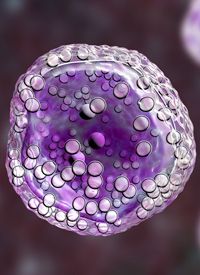Idasanutlin Promotes Transient Expansion of TP53-Mutant Subclones in Polycythemia Vera
November 25, 2020 - The oral MDM2 antagonist idasanutlin was found to promote expansion of TP53-mutant subclones among patients with polycythemia vera.

November 25, 2020 - The oral MDM2 antagonist idasanutlin was found to promote expansion of TP53-mutant subclones among patients with polycythemia vera (PV), according to an analysis published in Blood Advances.1
Additionally, the study showed that after stopping idasanutlin, the majority of TP53-mutant clones stabilized or decreased in size.
Utilizing MDM2 inhibiting nutlins to activate the P53 pathway has demonstrated clinical promise across multiple solid and hematologic cancer types. However, TP53-mutant subclone expansion is a particular concern as nutlin therapy is thought to stimulate subclone expansion.
The study is an additional analysis from a phase 1 trial of idasanutlin in patients with PV. Data from the phase 1 study, which were published in Blood, showed that oral idasanutlin elicited clinical responses with on-target TP53 pathway activation and was well tolerated among patients with treatment-refractory PV.2
From end-of-study sequencing of the phase 1 data, 5 patients were found to harbor 12 TP53 mutant subclones and were included in the additional analysis to determine transient TP53-mutant clone expansion. Notably, only 1 of these patients had a TP53 mutation identified at baseline.
Three of the 5 patients with TP53 mutant subclones were female and the median age among them was 63.2 years (range, 48-83). The average time on study for patients with evidence of TP53-mutant clonal expansion was 77.4 weeks. The number of TP53 mutations ranged from 1 (n = 2), 2 (n = 1), 3 (n = 1), and 5 (n = 1).
Clinical responses per European LeukemiaNet criteria showed that 2 patients had a complete response to idasanutlin, 2 had a partial response, and 1 had no response. Additionally, prior therapy included hydroxyurea (n = 4) and interferon (n = 2).
Patients with TP53 mutant subclones remained on the study longer compared those without TP53 mutant subclones (n = 7; 54.2 weeks). Additionally, mutated patients were more likely to have experienced more cycles of therapy and to have received higher doses of idasanutlin vs unmutated patients. This may suggest that expansion of TP53 mutant subclones can cause dose dependence.
Four out of the 5 patients with TP53-mutant subclones acquired the somatic TP53 mutations at the end of the idasanutlin trial time point. Further, these 5 patients had 26 identified oncogenic or likely oncogenic mutations in 9 cancer-related genes aside from TP53, including DNMT3A and ASXL1. The median number of somatic mutations per patient was 5 (range, 2-7) and JAK2 V61F was present among all patients. Four patients had copy-number neutral loss of heterozygosity of 9p, which includes the JAK2 gene and results in a biallelic JAK2 mutation in 75% of these patients.
TP53 mutations were detected in 9 distinct loci in these patients after idasanutlin. Further, 1 to 5 TP53 mutations were identified per patient, with 2 recurrent TP53 mutations present in the R248 codon (n = 3, R248Q; R248W, n = 2). Moreover, R248 can lead to acquisition of gain-of-functions mutations, which, if found in TP53, are highly associated with progressive disease and drug resistance.
Raw sequencing data reanalysis revealed that 2 of 12 mutations (R248W and V172D) were not detected in baseline samples, 2 were present at baseline with variant allele frequency (VAF) greater than 1% (248Q, 1.1%; 248W, 5.5%), and 8 were present at baseline VAF less than 1%. The other 2 mutations may have arisen de novo during therapy or were not detected at baseline due to loss of heterozygosity.
All VAFs of these TP53 mutations showed a relative increase during treatment with an average increase from 0.1% (range, 0%-5.5%) to 7.8% (range, 1.1%-36.7%) in somatic TP53 mutation VAFs from baseline to the last evaluable point during treatment (range, 4-33 months). One patient, who was the only patient to exhibit primary resistance to idasanutlin and harbored a R248W mutation at baseline (5.5%), had a significant, fivefold increase.
Four patients were available for resequencing after stopping idasanutlin (range, 4-14 months after treatment). Eight of the 9 TP53 mutations harbored by these patients decreased in VAF with 1 returning to baseline and 4 dropping below baseline. Notably, the patient who was resistant to idasanutlin had a VAF reduction.
Four patients with TP53 mutations have been observed since cessation of idasanutlin therapy. After 19 to 32 months, no patients have shown clinical evidence of disease progression to myelofibrosis of myeloproliferative neoplasm blast phase. Three patients have demonstrated stabilized peripheral blood counts without evidence of peripheral blood blasts or splenomegaly. One patient developed leukocytosis with less than 5% peripheral blood blasts. Moreover, this provides some evidence of clonal cytogenetic evolution because this patient developed a complex karyotype.
Clinical outcome results may be influenced by the addition of other therapies for PV, including phlebotomy, hydroxyurea, interferon, and ruxolitinib (Jakafi).
Moreover, due to the limited sample size and short follow-up time, the utility of TP53 as a prognostic biomarker remains largely unknown.
The study authors concluded that a larger study is needed to understand whether patients acquire de novo TP53 mutations after treatment with idasanutlin.
References
- Marcellino BK, Farnoud N, Cassinat B, et al. Transient expansion of TP53 mutated clones in polycythemia vera patients treated with idasanutlin. Blood Adv. 2020;4(22):5735-5744. doi:10.1182/bloodadvances.2020002379
- Mascarenhas J, Lu M, Kosiorek H, et al. Oral idasanutlin in patients with polycythemia vera. Blood. 2019;134(6):525-533. doi:10.1182/blood.2018893545



